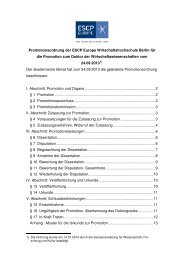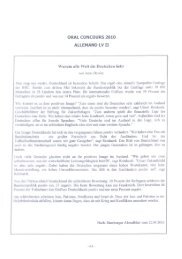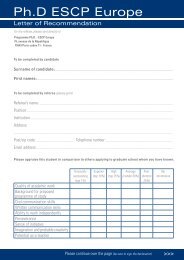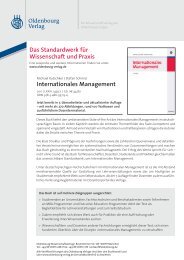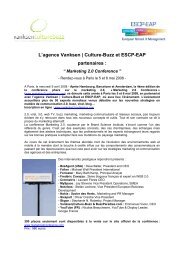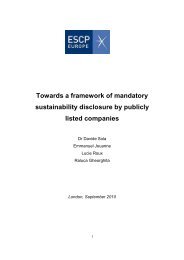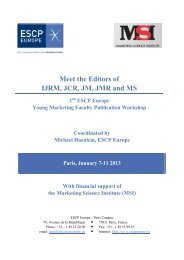WP 53_Jacob_neu - ESCP Europe Business School
WP 53_Jacob_neu - ESCP Europe Business School
WP 53_Jacob_neu - ESCP Europe Business School
You also want an ePaper? Increase the reach of your titles
YUMPU automatically turns print PDFs into web optimized ePapers that Google loves.
for the buying organization, a lot of information is exchanged between both<br />
parties. They are purchased in low quantities and irregularly. Customer’s<br />
requirements and needs are rather ill-defined. Due to the market offerings<br />
complexity, procurement managers will face similar problems as described for<br />
complex solutions in assessing the market offering prior to purchase. Thus,<br />
experience and credence attributes dominate.<br />
DMU Implications for Supplier-centric Market Offerings<br />
Reviewing our bipartite classification of facets of DMU, it becomes apparent that<br />
supplier-centric market offerings are rich in uncertainties stemming from the<br />
market offering and less susceptible to uncertainties stemming from the supplier.<br />
Since there is virtually no co-creation, i.e., no interaction between both parties<br />
throughout the production process, doubts about the customers resources and<br />
processes do not concern prospective customers. Still, due to the market<br />
offerings high perceived complexity, information asymmetries prevail, making the<br />
procurement manager susceptible to social uncertainties. Speaking of the market<br />
offerings complexities entails questions of technical, financial, and transaction<br />
uncertainties. In addition, the comparison between market offering alternatives is<br />
hampered due to the potential lack of alignability of the assortment (e.g.,<br />
Gourville and Soman 2005). Both factors may lead to increased customer market<br />
uncertainty. Furthermore, due to the variety of choice (emanating from the<br />
various and sometimes conflicting product attributes, and the consequential<br />
nature of the choice), paired with abstract requirements and needs of the<br />
customer, need and choice uncertainty may be at play. Although the production<br />
process of the market offering is not closely linked to the customer, due to its high<br />
importance to the customer and the involved high risk of the purchase, customers<br />
are interested in developing a relationship to the supplier. Moreover, customer<br />
value has a relatively more important role than for commodities.<br />
4.4 Low Market-offering Complexity/High Co-creation (LH):<br />
Customer-centric Market Offerings<br />
The LH quadrant is characterized by a relatively low degree of perceived marketoffering<br />
complexity and a high degree of co-creation of the market offering.<br />
Examples are “high contact services” (Chase 1978) like divers customer services<br />
(e.g., taxi, eat as you go, call center services, software and systems training and<br />
support), hospitality and tourism. For those services, the customer is constantly<br />
involved in the production process, i.e., a high degree of co-creation is taking<br />
place. For this reason we label this kind of market offering “customer-centric.” On<br />
the other hand, perceived complexity of the market offering is limited. Customers<br />
have well-defined requirements and needs. Due to easy to make comparisons<br />
and evaluations of the market offering delivery, price will play an important role<br />
for the purchase decision. Likewise, the supplier is able to deliver the service to a<br />
large amount of customers. Consequently, market offerings are delivered in a<br />
standardized way, although they are “people-based.” It is normally impossible to<br />
14



